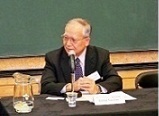Growing Pains and Growth Paths: China and Japan in Modern Economic Growth
Wellington Conference on Contemporary China 2011
Date: 5-6 December 2011

Leading scholars on China and and Japan gathered in early December to examine the the experiences of modern economic growth and development of China and Japan, at this year's Wellington Conference on Contemporary China, an international conference organized annual by the China Centre. This year's conference was co-hosted with the NZ Asia Institute of the University of Auckland.
China and Japan are two countries that have been related in critically different ways at different historical points. China dominated the region until the 19th century. The Meiji Restoration in the late 19th century in Japan set the two countries onto different paths of modern development. Japan’s leadership in East Asia’s rapid economic growth in the early post-World War II decades has further set itself apart from China. When China embarked on its economic reform and opening 30 some years ago, the two countries were so different in so many ways that not many would think they were even comparable.
Yet, 30 years later, there is increasing evidence that China is facing a similar turning point in its economic growth and social development, as Japan did in the 1980s: pressure for continual high-speed growth; greater availability of capital, skyrocketing real estate prices, largest banks in the world, need for industrial restructuring and upgrading, rising demand on wage and labour conditions, international pressure on exchange rate and for a “balanced” international economic structure; and growing tensions between increasingly pluralistic economic and social forces and interests, and the statist and corporatist political structure and institutions. Still yet, while Japan has clearly become a post-industrial society, one can find in China a mixture of material development, industrial organizations, institutional arrangements, policies and strategies, values and attitudes that can only be seen in vastly different historical periods of the early developers.
There are different possible explanations as to whether the challenge China faces today is fundamentally the same that Japan and indeed many major industrial economies experienced before. One obvious argument is that this is the modern market economy, one that is driven primarily by timely profits, which are shaped by resources and opportunities, information and access, prices and purchasing power, technology and geographic conditions, mass media and communication. The contingent and dynamic interplay of these forces creates a level of risk and uncertainty that encourages speculative and hedging behaviour. The modern market economy therefore operates on “business cycles” that allow the collective dynamics of economic activities to run their full course, whether one likes or not. In this perspective, China today, Japan in the 1980s and perhaps the United States in the 1930s are instances of being at a similar critical point in the cycle.
The challenge is also seen as uniquely that of the Asian model economies. Japan’s bubble and burst came after 30 years of rapid economic growth after World War II. The model relies on the state as the primary organizer and facilitator of national economic activities; exports and international markets as a principal generator of economic activities and thus income and profit; and advantages in institutional and organizational arrangements and human resources for the economy’s competitiveness. Such a model can continue to generate economic activities to sustain growth for a considerably longer period. At the same time, it builds up tensions among key elements of growth, to a point where either the economy upgrades, restructures, and grows out of the model; or the bubble bursts and the economy collapses; or somewhere between. While Japan’s lost decade in the 1990s seems an instance of the last scenario, China is yet to be presented with clear options as how to respond to this challenge of “growing pains.”
However, these approaches that use a shared growth and development model to homogenize development experiences seem to face significant theoretical and empirical challenges. Theories of late development, for example, argue that material, institutional and international conditions were different for the late developers. These conditions have led late developing economies to take different paths to grow and develop. Advocates of compressed development, on the other hand, not only recognize the different conditions facing development of different countries in different historical periods, but, more importantly, argue that the history of modern economic development at the national level is an accelerated process of compression of the conditions and dynamics for growth and development into an increasingly shorter timeframe. This has led to the late development which is significantly different from early development experiences.
Given the significant implications of how China responds to the challenge, understanding the nature of the growing pains and growth paths is crucial: in what ways are China’s problems in its economic growth and development today similar to or different from those of Japan in the 1980s? Are they similar because of the modern market nature of their economies? Or they are similar because they are all part of the East Asian model? Or are they different because of the changing material, institutional and international conditions? Can different strategies in response make a difference? How growth economics and development theories explain the differences? How all of these means for the international economic structure, global economic governance, regional economic cooperation and integration, and sustainable growth and development in the two countries?
